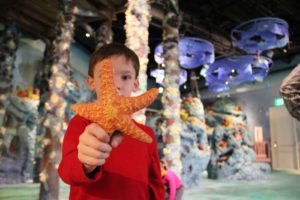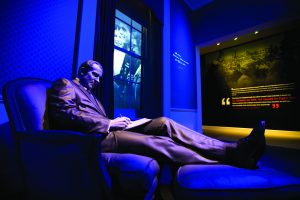The Museum Exhibit Design: Education Should Be Fun
- Blog Posts
Have you ever thought about a trip to a museum as the equivalent of eating your leisure-time vegetables? It’s good for you, but it’s not always the most palatable option on your plate. It’s vital that museums offer something more than just education. That they offer fun and excitement and inspiration and connection in order to avoid being relegated to brussels sprouts status. So when we start thinking about museum exhibit design and how to tell a story that appeals as it educates, it can be as simple as beginning where you would with any story: the who, the what, and the where.

Let’s start with the last of those: the where. Creating a sense of place isn’t just for theme parks, and museum exhibits don’t have to be displayed within formless or nonspecific gallery spaces. Giving guests a sense of location, an environment to explore, can transform their serving of educational goodness into a journey of discovery, even an adventure. Take, for example, our approach at NatureQuest, the children’s exhibit at Fernbank Museum of Natural History in Atlanta, Georgia. This indoor-for-outdoor space recreates the different environmental zones of Georgia, populated with species-accurate depictions of plants, animals, even the correct sounds of bird calls and other wildlife for that region. In this space, rather than being told about the estuary or swamp or mountain caves, kids and their parents get to become the discoverers, the scientists spotting species in their natural habitats and learning about them from their environments.

Next, let’s think about the who. While the where can immerse guests in a time or location, ultimately people connect with people. It’s the personal stories that provide unique moments of identification and communication between guests and the educational content. In museum exhibit design, this can mean creating opportunities to get inside someone else’s head, building empathy and understanding. At the Richard Nixon Presidential Library, we wanted to give guests a chance to see and hear how Nixon thought — in his own words — while balancing it with outside perspectives and responses. We recreated the Lincoln Sitting Room, Nixon’s favorite room in the White House, and placed a statue of the president at work in his chair, scribbling away on a notepad. Projected words animate onto the wall (real quotes from his own handwritten notes) as guests hear Nixon’s voice, from later interviews, narrating what he thought about a particular issue. The windows of the room were filled with media of news reports, commentary, even protests, giving a glimpse of how the outside world responded to Nixon’s actions.
Last of all, the what. In the context of museum exhibit design, the “what” that we’re specifically interested in are the artifacts — the real, authentic pieces of history (or geology or whatever field our museum is focused on) that tell a story with their physical presence. First, it’s important that you are choosing an artifact that has significance and a story to tell — you’re not just displaying it for the sake of having something in a case. At the CIA Museum[efn_note]Note: This project is used as an example only. Thinkwell Group did not work on this project[/efn_note] for example, the letter written to his son by a young American officer at the close of WWII might move guests in its own right, aided by the writer’s later role as Director of Central Intelligence. But the fact that the letter is written on a captured piece of Adolph Hitler’s personal stationery makes it unforgettable. Just as vital as what it is, though, is how the artifact is displayed: are you giving it the kind of context that makes it come to life? Can we see, through its environment or displays, how it was used or where it came from? Can guests touch or interact with it? It’s one thing to be able to see a rock that was brought back from the lunar surface, but to be able to touch one — as you can at Space Center Houston, among other locations — gives you a chance to physically connect with history, or even the universe.
Who, what, and where. When you take it back to the basics of storytelling, it becomes clear that museum exhibit design can be both delicious and nutritious — the best of both worlds.[efn_note]Special Thank You to Kate McConnell for her contributions on this post[/efn_note]
Related Posts
Embracing AI
- Blog Posts
Whether we like it as a tool or fear that...
Introducing Harry Potter: A Forbidden Forest Experience
- Blog Posts
- News
Follow a forest light trail and discover illuminated moments from the...